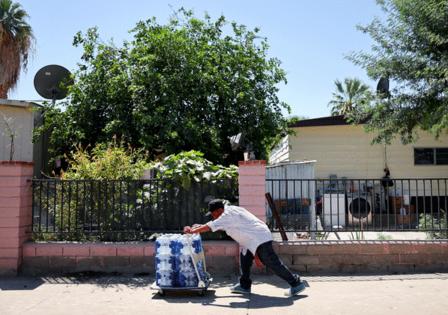Commentary: Which water is safest to drink?
Published in Op Eds
Source Water Protection Week reminds everyone how critical water is for our health and well-being. We take for granted that anytime we need to quench our thirst, bathe or wash our clothes, clean potable water will be available. Yet is this a safe assumption to make?
The United States water infrastructure is considered one of the most reliable in the world. The system is highly decentralized, with more than 148,000 municipal, county, and community organizations providing water for residents.
Most of the water that we consume is obtained from surface or groundwater systems. Surface water includes lakes and rivers, while groundwater is obtained from underground reservoirs. Public drinking water systems treat all such water to ensure that it is safe for consumption. Around 87% of the population relies on such systems for their water supply (as of 2015).
Yet once water leaves such systems, it passes through a network of pipes that allow people to turn on their faucets. Unfortunately, aging water systems may expose treated water to lead, a known health risk, especially to children.
In some cities, this infrastructure has existed for several decades. The Schaefferstown Water Company holds the distinction of operating the oldest water system in the United States, dating back nearly three centuries (1744). Water infrastructures in cities like Boston and New York create emergencies when water pipe breaks lead to extensive flooding and traffic disruptions. Every month, the list of water main breaks around the country grows. All such events are symptomatic of an aging water infrastructure that demands attention, yet often gets pushed aside in favor of more urgent public needs.
Given concerns about water safety from an aging infrastructure, people have turned to bottled water, particularly plastic bottled water. As of 2017, 1 million plastic bottles of water were sold each minute globally, with North America the world leader in such consumption.
Yet recent reports of plastic microparticles found in carotid arteries have raised concerns on the health impact of plastics in general, and their use for distributing water in particular. This creates a quandary for some, choosing between the risks associated with consuming plastic bottled water and the risks associated with tap water, though how to quantify such risks remains an open question.
We all need potable water. Yet with an aging infrastructure, its availability may become more challenged.
This is becoming most apparent in the U.S. West, where the Colorado River, which supplies water to several western states, is running low, also depriving Mexico of water. The Midwest drought is also creating water shortages, impacting farmers across the area.
All such factors make water a valuable public natural resource that may not always be available.
So what are possible solutions?
Consistent investment in critical infrastructure has been a problem in this country for decades. Much like preventive maintenance, it costs money to maintain the status quo but rarely visibly adds extra value. The infrastructure to support drinkable water needs a major upgrade.
The Biden administration recognized this plight, calling for significant critical infrastructure investments. Yet with so many critical infrastructures to address, water typically gets less attention than transportation and cyber systems.
The cost to make such an upgrade in the United States is estimated to be more than $2 trillion over the next decade, a significant outlay considering the large deficits that are already accumulating due to imbalanced budgets. Some communities are making such investments, with the cost ultimately being borne by users.
In some parts of the country, one gallon of water now costs over two cents. This is still relatively inexpensive compared to other liquids, like gasoline or alcohol, which are both regulated and highly taxed.
Will water eventually follow this pathway and become a taxed commodity even more than it already is?
In some parts of the world, where water is exceedingly difficult to find, the cost of water exceeds the cost of gasoline. For example, one gallon of water costs more than one gallon of gas in oil-rich Saudi Arabia.
Addressing problems before they become critical is not typically how United States governments operate. It often requires a crisis to spur changes and investments.
Donald Trump showed interest in modernizing the nation’s water infrastructure during his first term as president. Kamala Harris also expressed her concern for clean water as vice president. The only obstacle that both will face if elected is finding the money to put their concerns into action.
Availability of potable water is a crisis waiting to happen. Symptoms of this crisis are beginning to surface. Yet the risks are sufficiently great that efforts to address the situation today are not only a good idea, but also a necessary step to averting imminent water shortages and rising costs associated with our need (and thirst) for potable water.
____
Sheldon H. Jacobson, Ph.D., is a professor of computer science at the University of Illinois Urbana-Champaign. A data scientist, he applies his expertise in data-driven risk-based decision-making to evaluate and inform public policy.
___
©2024 Tribune Content Agency, LLC.




























































Comments